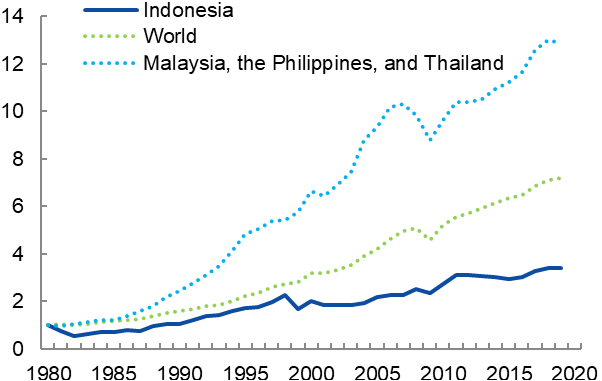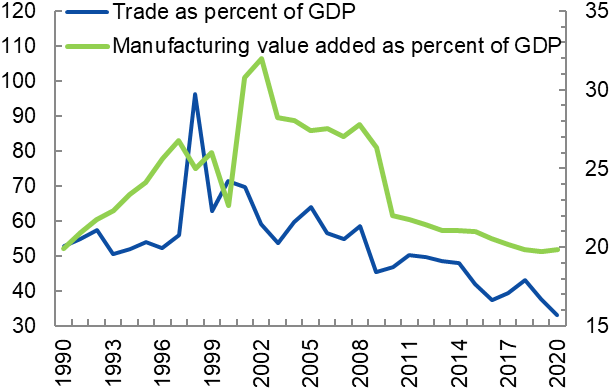
Indonesia’s Potential as an International Trading Powerhouse
Indonesia’s history, size, location, demographics, and resource endowments suggest that it should be an international trading powerhouse. Yet, evidence indicates that trade as an engine of economic growth has not been fully tapped.
The Sustainable Development Goals (SDGs)
The Sustainable Development Goals (SDGs) provide a framework for countries to achieve sustainable development by addressing social, economic, and environmental challenges. Trade can play a crucial role in advancing the SDGs by promoting economic growth, reducing poverty, and fostering sustainable development.
Trade Growth and Indonesia’s Lagging Performance
Supported by a steep decline in trade costs, advances in information technology, the liberalization of trade, and the expansion of global value chains, the volume of world exports increased by a factor of more than seven between 1980 and 2019. The volume of exports of regional peers such as Malaysia, the Philippines, and Thailand increased even more rapidly, rising by a factor of 13. In stark contrast, Indonesia’s exports rose by a factor of just 3.5 over this period (figure 1).

Figure 1: Indonesia’s exports of goods and services lagged behind the unprecedented expansion of global and regional exports since 1980
After the 1997–98 Asian financial crisis, Indonesia’s trade openness (exports and imports as a share of GDP) fell by more than half, coinciding with a period of deindustrialization. Its trade to GDP ratio fell from 72 percent in 2000 to 33 percent in 2020 and it is now the lowest among its regional peers. The contribution of manufacturing to GDP also declined significantly, falling from its peak of 31 percent in 2002 to 19 percent in 2021 (figure 2). In turn, the decline in trade openness has been limiting the contribution of trade to income growth given that global evidence suggests that a 1 percentage point increase in the ratio of trade to GDP increases income per capita by at least 0.5 percent (Frankel and Romer 1999).

Figure 2: The decline in the trade to GDP ratio in Indonesia coincided with a fall in the share of manufacturing over the past 20 years
Inward-looking trade policies have contributed to Indonesia’s weak trade outcomes:
- Tariffs declined, but they were offset by an increase in non-tariff measures (NTMs). The result has been a much less transparent trade policy framework and much less trade. Unnecessary and burdensome NTMs in the form of import approvals, mandatory certification with national standards, and restrictions on port of entry have led to efficiency and productivity losses for Indonesian businesses. These also have an adverse effect on exports, households, and investment decisions. Despite recent progress on reducing the incidence of NTMs such as pre-shipment inspections, these measures continue to impose a significant burden on Indonesian businesses—more burdensome than in other countries in the region.
- Indonesia’s restrictions on services trade are among the highest in the world, despite recent reforms. The Omnibus Law on Job Creation removed key barriers to foreign direct investment and relaxed restrictions on the movement of foreign workers. Additional reforms are needed, however, to realize the full potential of Indonesia’s services sector.
- Reforms are also needed to reduce the time, costs, and uncertainty of cross-border transactions.
Opportunities for Boosting Indonesia’s Trade
As it charts a path forward, Indonesia has significant scope to build on its comparative advantages to boost export growth and diversification. Its enormous trading potential, combined with major structural shifts in the international trading system, present it with significant opportunities. Among the structural forces that could favor Indonesia are the post-COVID-19 reconfiguration of global value chains, the relocation of labor-intensive manufacturing away from China, and the global transition to a low-carbon economy.
An enabling trade policy framework could play a critical role in helping Indonesia boost exports and competitiveness, supporting the government’s objective of becoming a high-income country by 2045. As outlined in the December 2022 Indonesia Economic Prospects report, targeted reforms are needed (figure 4). Among the most essential are the following:
- Streamlining and eliminating unnecessary NTMs
- Removing barriers to services trade
- Deepening and expanding the number of trade agreements
- Improving logistics and trade facilitation
- Aligning trade policies with green development.
While promoting economic growth and prosperity, trade liberalization will create winners and losers. Domestic policies to address inequalities and trade-related adjustments are key to ensuring that the gains from trade are equitably distributed. Trade reforms combined with such policies are critical to unleashing the benefits of trade for economic growth and the well-being of the Indonesian people.
Figure 3: Imports are a crucial input in production
SDGs, Targets, and Indicators
1. Which SDGs are addressed or connected to the issues highlighted in the article?
- SDG 8: Decent Work and Economic Growth
- SDG 9: Industry, Innovation, and Infrastructure
- SDG 10: Reduced Inequalities
- SDG 12: Responsible Consumption and Production
- SDG 17: Partnerships for the Goals
2. What specific targets under those SDGs can be identified based on the article’s content?
- SDG 8.1: Sustain per capita economic growth in accordance with national circumstances and, in particular, at least 7 percent gross domestic product growth per annum in the least developed countries.
- SDG 9.1: Develop quality, reliable, sustainable, and resilient infrastructure, including regional and transborder infrastructure, to support economic development and human well-being, with a focus on affordable and equitable access for all.
- SDG 10.2: By 2030, empower and promote the social, economic, and political inclusion of all, irrespective of age, sex, disability, race, ethnicity, origin, religion, or economic or other status.
- SDG 12.2: By 2030, achieve the sustainable management and efficient use of natural resources.
- SDG 17.11: Significantly increase the exports of developing countries, in particular with a view to doubling the least developed countries’ share of global exports by 2020.
3. Are there any indicators mentioned or implied in the article that can be used to measure progress towards the identified targets?
- Volume of exports of goods and services
- Trade to GDP ratio
- Contribution of manufacturing to GDP
- Tariffs and non-tariff measures (NTMs)
- Restrictions on services trade
- Time, costs, and uncertainty of cross-border transactions
- Imports as a crucial input in production
Table: SDGs, Targets, and Indicators
| SDGs | Targets | Indicators |
|---|---|---|
| SDG 8: Decent Work and Economic Growth | Sustain per capita economic growth in accordance with national circumstances and, in particular, at least 7 percent gross domestic product growth per annum in the least developed countries. | Volume of exports of goods and services |
| SDG 9: Industry, Innovation, and Infrastructure | Develop quality, reliable, sustainable, and resilient infrastructure, including regional and transborder infrastructure, to support economic development and human well-being, with a focus on affordable and equitable access for all. | Trade to GDP ratio |
| SDG 10: Reduced Inequalities | By 2030, empower and promote the social, economic, and political inclusion of all, irrespective of age, sex, disability, race, ethnicity, origin, religion, or economic or other status. | Contribution of manufacturing to GDP |
| SDG 12: Responsible Consumption and Production | By 2030, achieve the sustainable management and efficient use of natural resources. | Tariffs and non-tariff measures (NTMs) |
| SDG 17: Partnerships for the Goals | Significantly increase the exports of developing countries, in particular with a view to doubling the least developed countries’ share of global exports by 2020. | Restrictions on services trade Time, costs, and uncertainty of cross-border transactions Imports as a crucial input in production |
Behold! This splendid article springs forth from the wellspring of knowledge, shaped by a wondrous proprietary AI technology that delved into a vast ocean of data, illuminating the path towards the Sustainable Development Goals. Remember that all rights are reserved by SDG Investors LLC, empowering us to champion progress together.
Source: blogs.worldbank.org

Join us, as fellow seekers of change, on a transformative journey at https://sdgtalks.ai/welcome, where you can become a member and actively contribute to shaping a brighter future.







